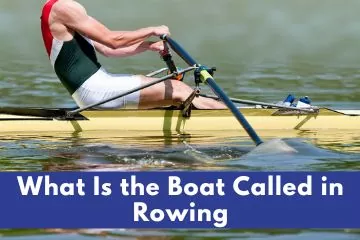
Hi, my rowing friends! OK, Hi to all my “considering rowing” friends as well!
I’m Petra, and today, I want to talk about rowing on the water and the terminology we use.
We use various names for different types of rowing boat, depending on the type of rowing a person will be doing and how many people are in the boat.
Whether you are only interested in watching races, considering taking up rowing, or have an indoor rowing machine but you like it so much you’re thinking of rowing on the water, this article will be of interest to you.
Let’s dive in head first and get our feet wet, so to speak.
What Is the Name of the Boat Used for Rowing?
First, let’s clarify the difference between “rowing” and “sculling”.
Rowing is the general term for the sport that involves propelling a boat using oars, and there are two ways to do it—sweep rowing and sculling.
Sweep rowing involves at least two people, each holding one oar, to keep the boat balanced and moving in the right direction.

Sculling is when one person holds two oars. This means that you can have just one person in the boat (there can be more).
The most common name for the boat itself is the shell. However, you might also hear the word scull or sculling boats used.
Don’t let these terms confuse you. The people rowing are also sometimes referred to as sculls, especially if they are racing or sculling.
There are lots of different terms, but the most common ones you will hear for the boat is the shell or the scull.
What Are the Types of Sculling Boats?
The names for sculling boats will depend on how many rowers there are in the boat and the number of oars each rower is using.
- A single boat with one person holding two oars is called a Single Scull
- A Double Scull will have two rowers with two oars each. One person will steer the boat using a rudder controlled by a foot pedal
- A Coxless Quad has 4 people in the boat, each with two oars
- A Coxed Quad also has 4 people rowing, but there is a coxswain who not only steers the boat but also shouts encouragement
- An Octuple Scull has 8 rowers and a coxswain. You won’t see this one in typical races and it is mainly for beginners. Side Note: Check out Rebecca’s great article on Head Race Rowing
What Is a Single Rowing Boat Called?
As I mentioned above, a boat designed for sculling that holds just one person with two oars is often referred to as a shell, but it can also be called a scull. The person doing the sculling is also called a scull or a rower, or even a racer or participant.
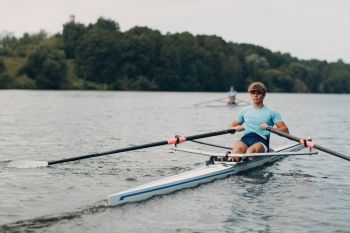
This sounds confusing since the same name is used for several different rowing boats and people, but it’s not as bad as it may sound at first.
Once you start listening to the announcers at a race, you will hear the same words over and over.
Many times, the sport of rowing (with a single rowing boat) is called sculling, and the boat itself is called the shell.
Related Post: What is Sculling in Rowing?
What Are the Types of Sweep Rowing Boats?
Now when it comes to sweep rowing (where each rower has only one oar), there are similar names for the rowing boats or sweep boats used:
- A Coxless Pair holds two rowers, each with a single oar handle
- A Coxed Pair has two rowers, each with one oar, but there is also a coxswain to steer the shell.
- A Coxless Four has 4 rowers, each with a single oar handle. One of the rowers will steer the boat using rudder that has a foot control
- A Coxed Four also has 4 rowers but it also has a coxswain to steer the boat
- A Coxed Eight has eight rowers and a coxswain to steer the boat
These terms are fairly self-explanatory once you remember the difference between a coxless and coxed boat. Read more here on what does a rowing coxswain do and say.
What Are Olympic Rowing Boats Called?
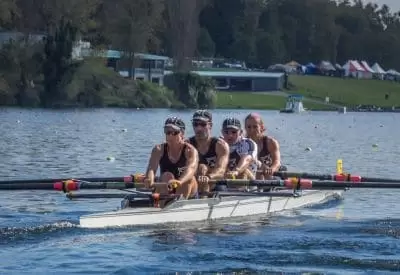
Actually, there isn’t usually any difference between the racing shells used in national or state races and the Olympic games. Olympic rowing boats are still called shells, generally. They can also be called sculls for sculling events.
What actually changes is the type of rowing race that is being run on any given day and how many people are in each racing shell. So you will also hear the racing boats called single scull, double scull, quad, pair, four, and eight, depending on the event.
Remember that you can have sweep boats (sweep rowing) where one person holds one oar, or you can have sculling races, where one person holds two oars.
Shells come in many different lengths, with the largest being the Eight, which is about 62 feet and weighs 200 pounds or more.
Don’t be shocked, however, if you should see a single scull that is a mere 10 inches across! Balance is the key to using these tiny shells!
What Are Shells Made of?
Shells were originally made of wood, but the type of wood and design varied over the years to be sure. In the 1870s, a type of papier-mâché was tried. Then, a fine plywood was used inside of a fiberglass shell.
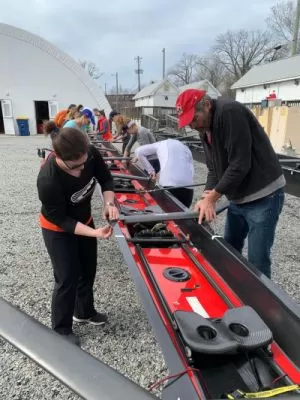
Today, nearly all modern racing shells are made from carbon-fiber, reinforced plastics using a honeycomb-type structure.
The best shells are known for how stiff they are. The less that a shell flexes means that more power is directed to moving the boat rather than twisting the frame.
What Are the Different Parts of a Shell Called?
Great question.
- Each rower will sit on a sliding seat. No special name here, this is simply called the seat.
- The foot stretcher and footplate hold a pair of special shoes that are actually screwed into place. Each rower will put their feet in the shoes and strap themselves in so their feet stay in place. The stretcher is what holds the shoes and the footplate is what the shoes sit on.
- The saxboard is the top edge of the boat. Imagine holding on to the saxboard as you lower your butt onto the seat. The saxboard is also what the rigger is attached to.
- The rigger or outrigger is what will hold the oar blade in place.
- Each part of the oar blade also has a name. The handle is what the rower will hold on to. The bar between the handle and the oar blade itself is called the loom.
- Close to the handle of the oar is an important part called the collar or button. This small piece is vital because it prevents the oar handle from falling through the rigger if the rower should somehow lose their grip on the oar. Nothing would be more embarrassing than to lose an oar mid-race because it fell out of your hands and into the water!
- The last part on the oar is called the sleeve. This is below the collar and this small piece allows the rower to twist the oar (called feathering) from the vertical to a horizontal position. Feathering reduces wind resistance during the recovery stroke.
A sweep oar is typically 12 or 13 feet long, while sculling oars are only about 9-10 feet long.
I know this may seem like a great deal of new terminology, but if you can take a look at a shell and the oars in person, I bet you will have no problem naming almost every single thing we have discussed here.
What Is the Rowing Stroke Rate in Races?
Rowing stroke rates help determine how fast the shell is going, and a good coxswain can use this information to help their crew win the race.
If you’ve ever watched rowing races on television, you might have seen the stroke rate for a particular boat shown on the screen.
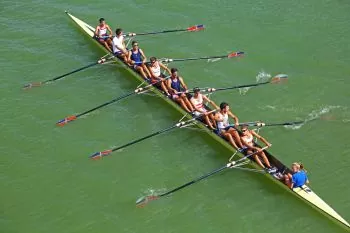
This information comes from a small electronic device on the boat that the coxswain can see.
For example, if the coxswain already knows that the maximum number of strokes per minute (SPM) that their crew can do is 16 and sees that they are only halfway through the race, the cox might call for their team to cut back for a minute so they don’t wear themselves out and slow down near the finish line.
Conversely, if they’re near the finish line doing 18SPM, the coxswain, knowing the team can do a bit better (or at least hope the rowers still have some strength in them!), can call out for a Power10. This is to motivate the rowers to give 10 of their best, fastest, most powerful strokes possible.
So if you are watching a race on television and see numbers like 20SPM and another boat that says 18SPM, don’t be surprised if the second boat crosses the finish line first because it’s totally possible.
Going fast isn’t everything, but it is a vital part of any sprint race. Side Note: You might also like to learn tips on how to balance your rowing training from our expert rower Rebecca.
A Glossary of Terms
This isn’t a complete list, but I hope it will give you a quick reference in case you forget what something is called. Bookmark this page so you can refer to it quickly. Maybe you can even win a bet at your local pub when it comes to rowing trivia!
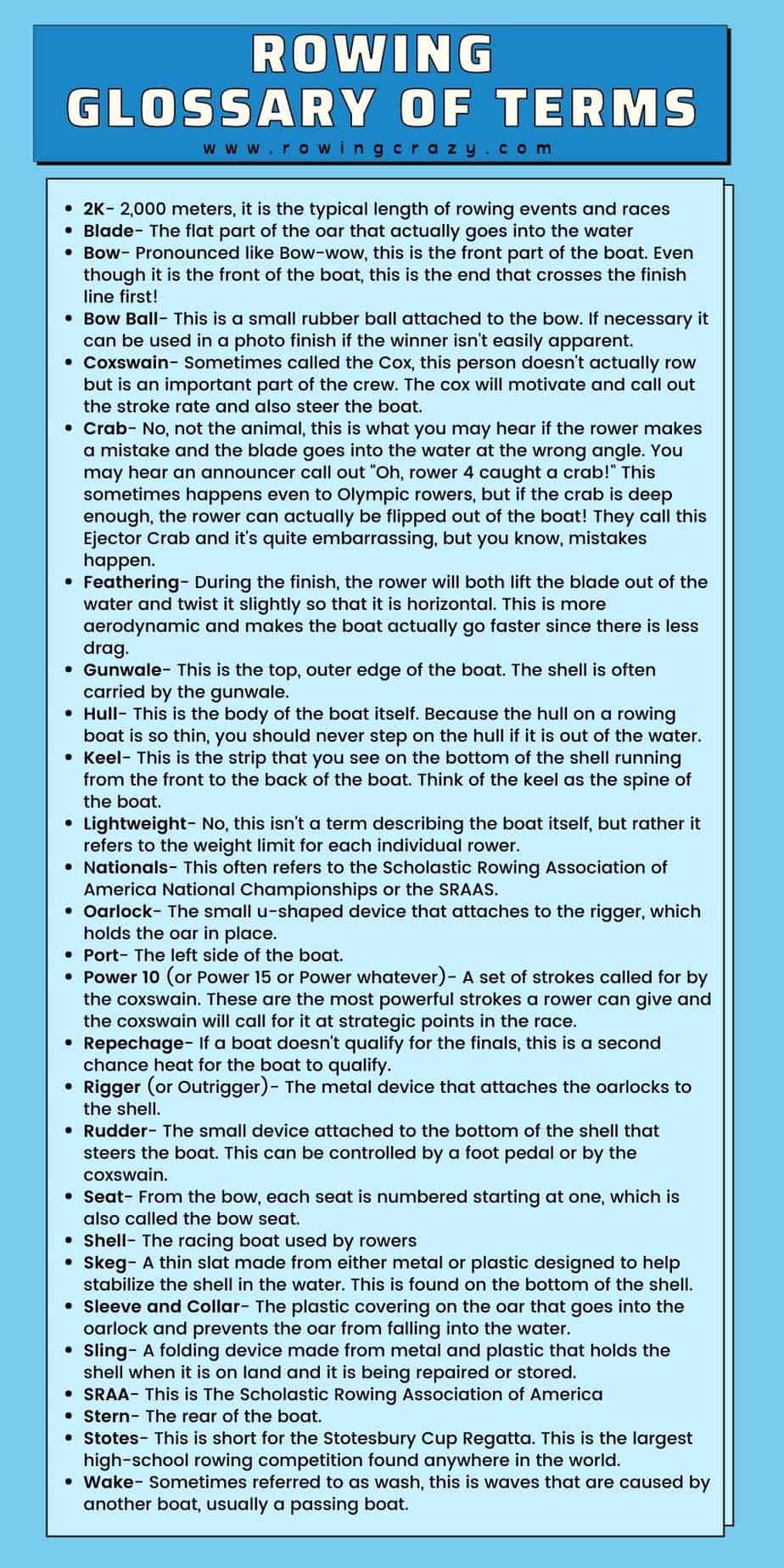
- 2K– 2,000 meters, it is the typical length of rowing events and races
- Blade– The flat part of the oar that actually goes into the water
- Bow– Pronounced like Bow-wow, this is the front part of the boat. Even though it is the front of the boat, this is the end that crosses the finish line first!
- Bow Ball– This is a small rubber ball attached to the bow. If necessary it can be used in a photo finish if the winner isn’t easily apparent.
- Coxswain– Sometimes called the Cox, this person doesn’t actually row but is an important part of the crew. The cox will motivate and call out the stroke rate and also steer the boat.
- Crab– No, not the animal, this is what you may hear if the rower makes a mistake and the blade goes into the water at the wrong angle. You may hear an announcer call out “Oh, rower 4 caught a crab!” This sometimes happens even to Olympic rowers, but if the crab is deep enough, the rower can actually be flipped out of the boat! They call this Ejector Crab, and it’s quite embarrassing, but you know, mistakes happen. Read more about on water rowing technique tips here
- Feathering– During the finish, the rower will both lift the blade out of the water and twist it slightly so that it is horizontal. This is more aerodynamic and makes the boat actually go faster since there is less drag.
- Gunwale– This is the top, outer edge of the boat. The shell is often carried by the gunwale.
- Hull– This is the body of the boat itself. Because the hull on a rowing boat is so thin, you should never step on the hull if it is out of the water.
- Keel– This is the strip that you see on the bottom of the shell running from the front to the back of the boat. Think of the keel as the spine of the boat.
- Lightweight– No, this isn’t a term describing the boat itself, but rather it refers to the weight limit for each individual rower.
- Nationals– This often refers to the Scholastic Rowing Association of America National Championships or the SRAAS.
- Oarlock– The small u-shaped device that attaches to the rigger, which holds the oar in place.
- Port– The left side of the boat.
- Power 10 (or Power 15 or Power whatever)- A set of strokes called for by the coxswain. These are the most powerful strokes a rower can give and the coxswain will call for it at strategic points in the race.
- Repechage- If a boat doesn’t qualify for the finals, this is a second chance heat for the boat to qualify.
- Rigger (or Outrigger)- The metal device that attaches the oarlocks to the shell.
- Rudder– The small device attached to the bottom of the shell that steers the boat. This can be controlled by a foot pedal or by the coxswain.
- Seat– From the bow, each seat is numbered starting at one, which is also called the bow seat.
- Shell– The racing boat used by rowers
- Skeg- A thin slat made from either metal or plastic designed to help stabilize the shell in the water. This is found on the bottom of the shell.
- Sleeve and Collar- The plastic covering on the oar that goes into the oarlock and prevents the oar from falling into the water.
- Sling- A folding device made from metal and plastic that holds the shell when it is on land and it is being repaired or stored.
- SRAA- This is The Scholastic Rowing Association of America
- Stern- The rear of the boat.
- Stotes- This is short for the Stotesbury Cup Regatta. This is the largest high-school rowing competition found anywhere in the world.
- Wake- Sometimes referred to as wash, this is waves that are caused by another boat, usually a passing boat.
There are quite a few more, but these are some of the most common terms that you will hear in rowing.
Other Rowing Terms & Expressions
- Boneyard – This is common slang that is used in rowing to describe where the shells are stored in between races.
- Ergs don’t float – An Erg is the performance monitor used on indoor rowing machines. A fast erg time won’t necessarily get transferred when rowing on the water. This means that someone who rows fast on an indoor rowing machine might not be the best rower in a rowing boat.
- Way enough – If you hear what sounds like someone shouting “Wayne’s Off!” what they are actually saying is Way Enough, which means to stop rowing.
- Fat ergos– A fat ergo means someone has very fast times on a rowing machine. Skinny ergos are slow times, and you don’t want to be known for that.
- Bi-Sweptual– Not to be confused with bisexual, Bi-Sweptual rowers don’t mind whether they row port or starboard. Most rowers have a preference, but if you don’t, you are bi-sweptual.
If you hang around long enough, you will become familiar with some of the other slang and local terms that people use in your part of the country. Side Note: Learn the difference between rowing heavyweight vs lightweight
The Bottom Line
I’ve tried to cover everything that I think a newbie will want to learn. There is so much more to rowing than just who crosses the finish line first!
If you’ve enjoyed this article and found it informative, feel free to pass it along to your friends or others who may find it helpful.
Rowing is such an exciting sport even for spectators. Everyone loves a winner, so don’t be surprised to find the coxswain on the winning team being tossed in the water. This isn’t an insult but a fun way rowers express their fondness for the sport and their crew.
Stay happy and keep rocking and rowing!
Written by Petra Amara – RowingCrazy.com
CEO & Founder of RowingCrazy, National Rower, Coxswain Womens Eight Team, Rowing Coach & Writer
Petra is a Mother of two and owner of Rowingcrazy.com. Petra lives and breathes rowing, she also has a passion for writing which lead her to start RowingCrazy.com to share her rowing experience and expertise with others.



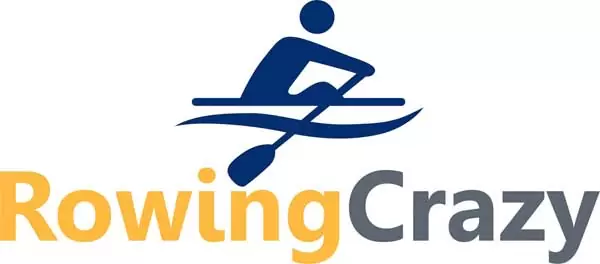


Pingback:
Pingback: